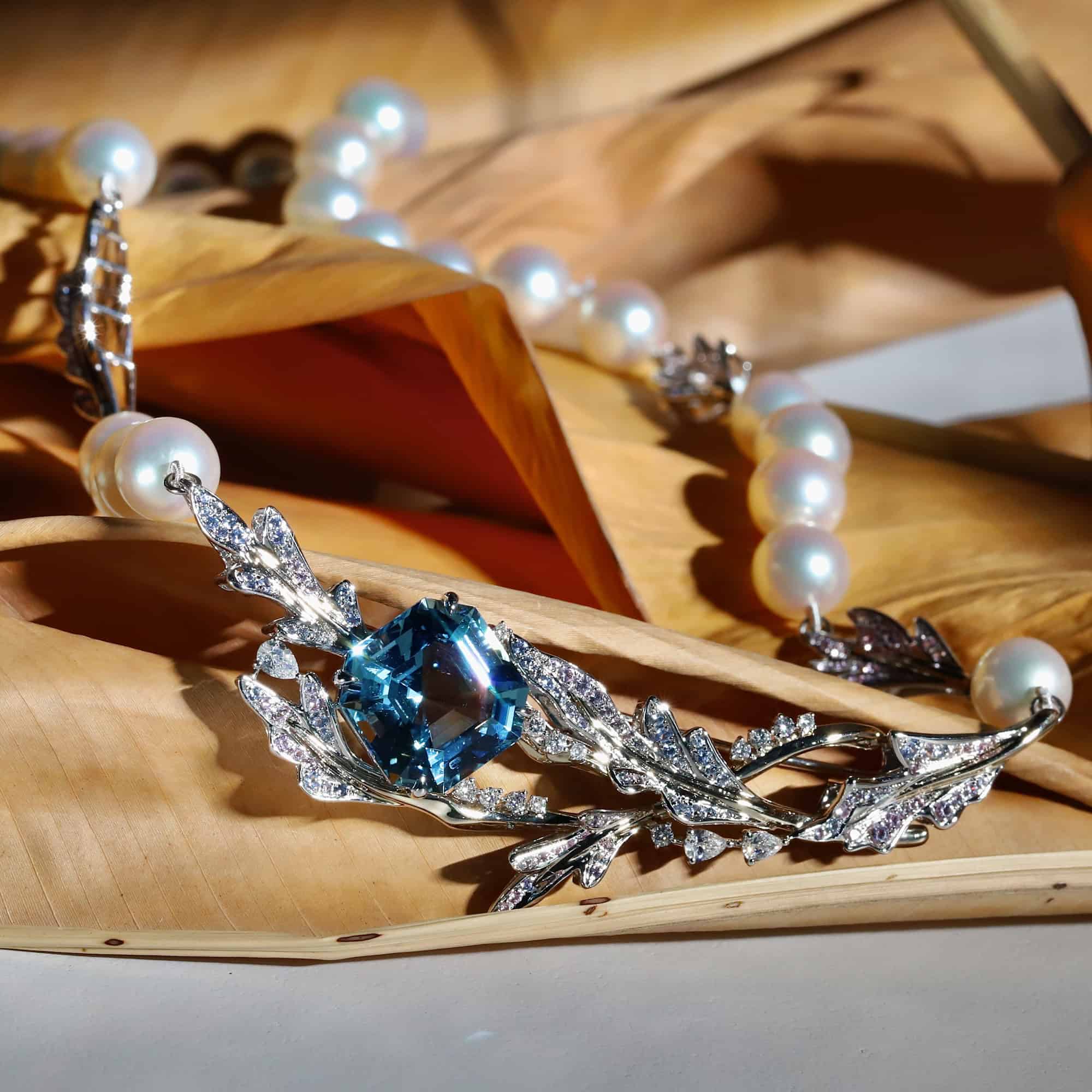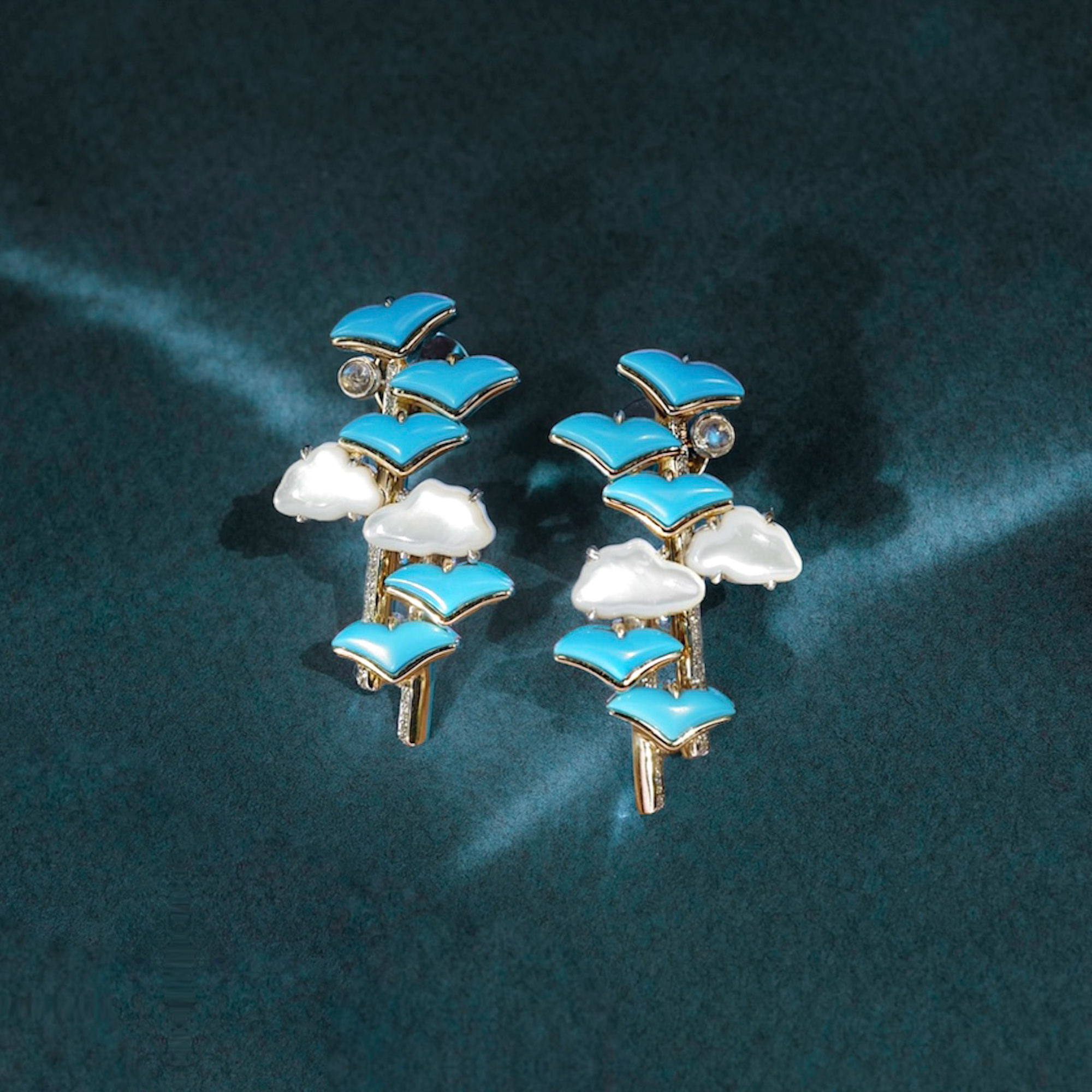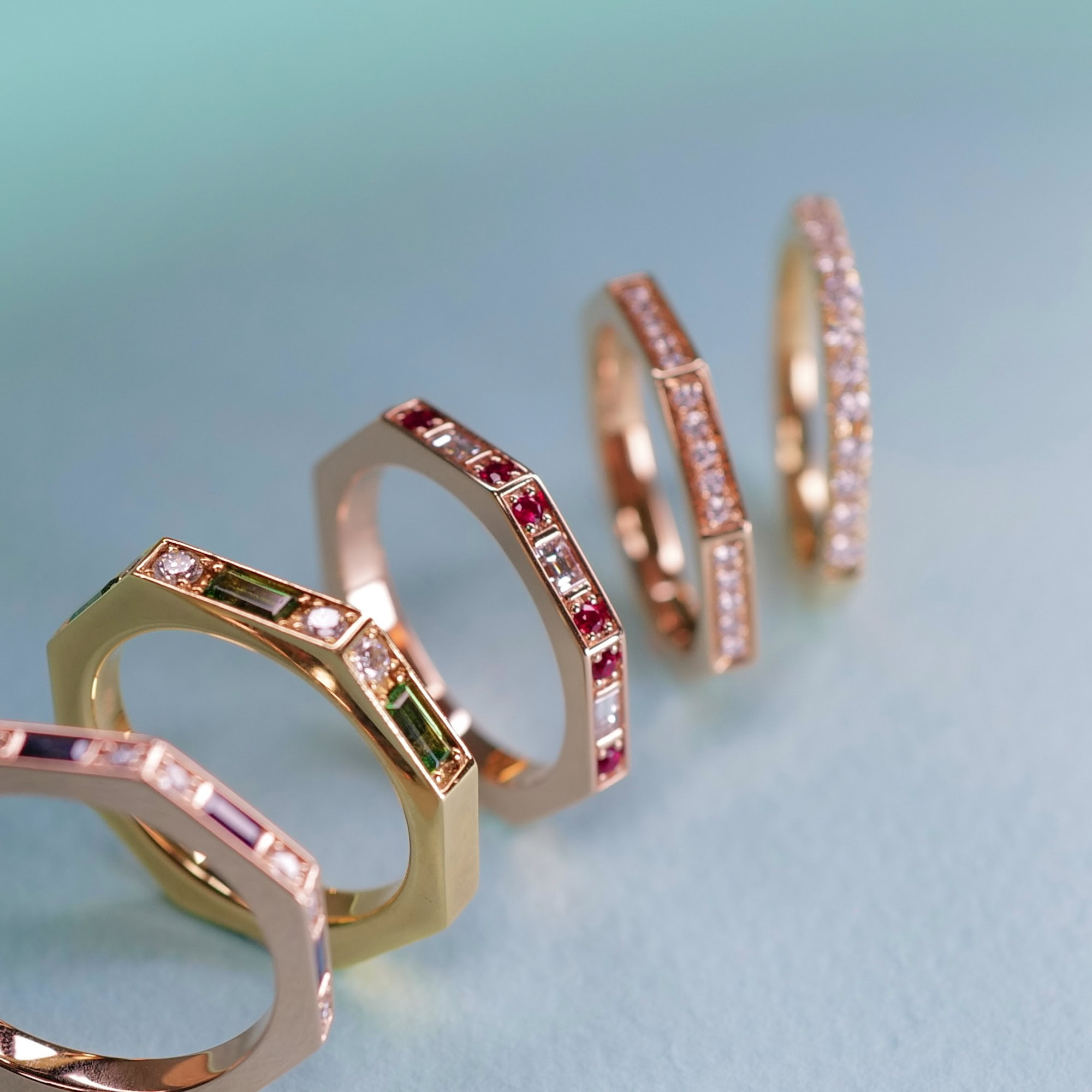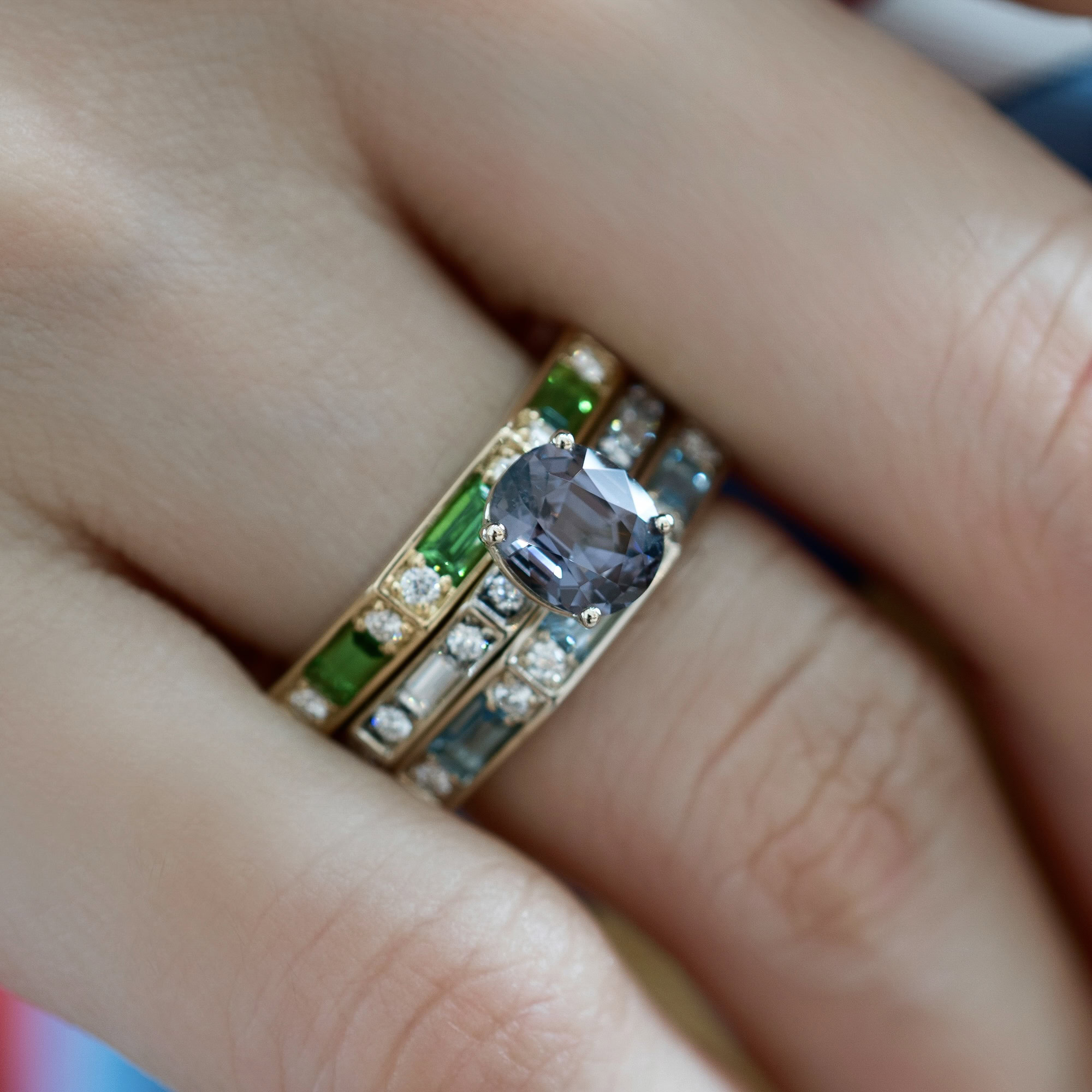Aquamarine derives its name from the Latin words “aqua” (water) and “marina” (sea), perfectly capturing its association with the ocean. It’s no wonder that aquamarines have become highly coveted gemstones, as they effortlessly evoke the serene tranquility of the sea, with every facet of their being seemingly connected to its essence.
Now, let’s explore the captivating realm of aquamarine in greater detail. Here, we’ll provide you with everything you need to know about this enchanting gemstone.
Properties of Aquamarines:
Let’s start with some factual and technical aspects. When considering a precious gemstone for a new jewellery piece, it’s always wise to be well-informed in order to make the most knowledgeable decision possible.

First and foremost, aquamarine belongs to the superior-quality beryl mineral family, which also includes morganite and emerald. However, it differs structurally from its renowned green sibling. While both are beryllium aluminium silicates, emerald derives its colour from trace amounts of chromium and vanadium, whereas aquamarine’s hue comes from iron impurities within its otherwise colourless crystal. Varying concentrations of these elements give rise to the distinct and extraordinary blues found in aquamarine.
Let’s move on to its attributes. Aquamarines are generally eye-clean, meaning they rarely contain visible inclusions when examined with the naked eye. Their exceptional clarity and transparency make colour the most significant characteristic. Larger stones tend to display more intense colouration, and darker blue shades are highly prized.
On the Mohs scale of hardness, aquamarine ranks at 7.5 to 8. This places it in the category of high resistance to scratches, making them ideal for daily wear.
Aquamarines form in large, hexagonal crystals that can reach up to 35 centimeters in length. This makes them highly prized by gem cutters, as they can be fashioned into larger carats, allowing for experimentation with innovative techniques that would not be possible with softer stones.

Origin of Aquamarines:
Historical accounts first documented the appearance of aquamarines in the early 1700s in the Adun-Chalon Siberian mountains. By around 1830, the finest quality aquamarines were being produced in the Brazilian gem fields of Minas Gerais and the Urals in Russia.
Today, Brazil remains a major supplier, although many African nations, such as Nigeria, Mozambique, Madagascar, and Zambia, also provide specimens of equal quality. However, the Brazilian aquamarines still hold a higher status historically. They occur in pegmatites and alluvial deposits of gravel. The renowned “Santa Maria aquamarines” from the state of Minas Gerais have dazzled the world with their highly saturated sky-blue colours, becoming favourites of the British royal family and notably gifted to US First Lady Eleanor Roosevelt in a spectacular rectangular step-cut 1.298-carat piece.
The Santa Maria mine has since been depleted, making this variety very rare and highly priced, with many stones found on vintage pieces mounted in exceptional Art Deco jewellery. These aquamarines are often faceted in large step-cuts to showcase their colour, and their almost mystical allure makes them highly sought after by collectors.
While the term “Santa Maria” is still used in the gem trade, it mostly signifies stones of excellent colour but not necessarily from the original mine.


Colour and Appraisal Criteria:
As previously mentioned, colour is undeniably the most important quality determinant for aquamarines. They are most commonly light in tone, ranging from nearly translucent cerulean to intense blue-green or teal. However, deep and intense blues are considerably more valuable (often classified as ‘AAA’) than the lighter shades, which are more readily available. Ultimately, colour preference is a matter of personal taste.
Fashion trends have played a significant role in shaping the popularity of gemstones throughout history. In the 19th century, sea-green aquamarine jewels were particularly sought after, becoming the “darling” choice of renowned Art Nouveau names like René Lalique. As time progressed, there was a shift in demand towards more intense shades of blue.
Preferences for specific hues continued to evolve throughout the century. Surprisingly, lighter shades became highly coveted at one point, thanks to the stone’s unique sparkle, which some found even more enchanting in pale colours.
Other evaluation criteria to consider are cut, clarity, and carat weight.
The gemstone’s cut is crucial to its overall appearance. An expertly cut aquamarine enhances the evenness and saturation of its colour. While aquamarines can be fashioned into various shapes, experts often favour emerald cuts, round brilliants, or ovals. Thankfully, well-cut aquamarines are quite common due to the abundance of rough material. Sculptors and artists appreciate them for fantasy cuts and ornamental objects.

When it comes to clarity, most faceted aquamarines are free from visible inclusions. Some crystals may exhibit liquid inclusions, but overall, clarity features are scarce or nonexistent in finished gems. Stones that do contain eye-visible inclusions are often fashioned into cabochons, beads, or carvings.
As for carat weight, aquamarines can be found in a wide range of sizes, from very small to very large. However, smaller stones are rarely considered saturated enough to be highly desirable. Nevertheless, certain mines in Africa reportedly yield intense-colored gems under 5 carats. Consequently, top-quality aquamarines of remarkable colour may fetch a higher price per carat than larger stones.
History:
Recorded history marks the discovery of aquamarine in the 1700s, but unofficially, its origins can be traced back much further. Strong indications of Sumerian, Egyptian, and Hebrew involvement and attachment to aquamarine have been found. Beads buried with Egyptian mummies provide evidence of its use dating back to ancient times. Going as far as the Romans and Greeks, there is evidence that these civilizations held aquamarine in high regard. Nobles of that era believed that the god of the sea, Poseidon, was forged from aquamarine itself. Romans also believed in the gem’s power to foretell the future, reconcile enemies, and aid in treating overeating and bloating. In the Middle Ages, it was rumored to provide protection against poisoning, a common concern at the time.
Perhaps the most commonly known association is aquamarine’s connection to sailors. It was believed to protect sailors from the wrath of turbulent waters and bring them luck in catching fish. Many civilisations kept a piece of aquamarine close to their bodies during sea voyages, believing it would ensure a safe journey. Aquamarine’s meaning was often linked to serenity, purification, and wisdom.

Use in Jewelry:
Aquamarine gained widespread popularity in both Art Nouveau and Art Deco jewelry from the late 19th century onwards. During the Art Nouveau era, artists rebelled against the rigid Victorian era, incorporating aquamarine into their designs to depict the natural world. Swirling golden lines often adorned jewelry pieces during this period.
Art Nouveau remained an inspiration for contemporary jewellers, and renowned designers like René Lalique showcased aquamarines in intricate pieces during the late 19th century. Lalique’s affinity for the blue allure of aquamarines not only boosted their popularity at the time but also influenced designers worldwide.
Thanks to its regal-like sophistication and alleged protective qualities, aquamarines have been favoured by royals throughout history. From Queen Elizabeth II to Princess Diana, they have turned to aquamarines for their jewellery. When Princess Diana was seen wearing a dazzling aquamarine ring and bracelet set, it became an instant sensation, and sales soared.

Considering bridal traditions, aquamarine is a perfect “blue” for the big day. Its delicate shade and mesmerising sparkle are undeniably chic and flattering when worn as earrings, bringing a luminosity to the face.
Aquamarine is also one of the birthstones for March and is associated with 19th wedding anniversaries.
Other notable uses of aquamarine include Tiffany & Co.’s stunning necklace designed for the 2013 film adaptation of “The Great Gatsby.” Featuring a 49.59-carat emerald-cut aquamarine surrounded by diamonds and platinum, it was inspired by the vintage styles of the 1920s. In addition, a Bulgari necklace with a prominent 13.05-carat gem, encompassed by the house’s signature diamond serpent, was sold to singer Justin Bieber during the Cannes Film Festival’s annual Cinema gala. Interestingly, he outbid Leonardo DiCaprio, paying $545,000 for the piece, which became a loving gift for his mother.

Our Verdict:
Aquamarines possess a remarkable clarity that imparts a sense of purity highly sought after in gemstones. Their wide range of colours and sizes make them perfect for stunning jewellery creations.
With their beautiful blue hue and captivating brilliance, it’s no wonder that aquamarines continue to rise in popularity. A 2019 study estimated that £15 billion worth of these gemstones are sold each year, indicating their immense popularity among buyers.
Furthermore, in recent times, deep-coloured aquamarines of superior quality are becoming increasingly rare, leading to a significant rise in market prices. This is particularly true for the previously mentioned “Santa Maria” varieties. Additionally, there is growing interest in pastel shades, with many individuals opting for lighter-coloured stones, contrary to the long-established preference for vivid blues. Overall, this is an opportune moment to acquire aquamarines, as supplies are not yet depleted, and their popularity continues to climb. However, regardless of trends, aquamarines have proven to be timeless classics that will always be cherished.
In conclusion, we can confidently affirm that aquamarine lends its intense clarity and exceptional brilliance to create fantastic fine jewellery pieces.




